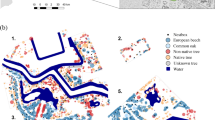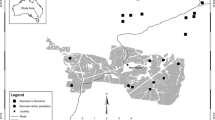Abstract
Vertebrate studies have rarely investigated the influence of spatial variation in habitat richness on both short-term (breeding) and long-term (offspring recruitment) reproductive performance using simultaneously multi-patch, multi-habitat type and multi-year approaches at landscape level. Here we present results of such an approach using the influence of two oak tree (Quercus ilex, Q. humilis) species on reproductive performance in Corsican blue tits (Parus caeruleus ogliastrae) as a model system. We found that blue tits breeding in rich broad-leaved deciduous patches consistently laid eggs earlier in the season, and produced larger clutches and more fledglings of higher quality, than those breeding in poor evergreen patches. Also, parents, especially males, were in better physical condition in the broad-leaved deciduous than in the evergreen patches. Surprisingly, estimates of long-term effects of reproduction, such as recruitment rates of locally born offspring, did not differ between the two habitat types. Our results suggest that short-term breeding performance and phenotypic quality of both chicks and parents do not necessarily provide reliable information about contributions to following generations at a scale larger than that of the local study plot. Differences in reproductive performance between the two oak habitat types could not be attributed to density-dependent effects, differences in levels of nest predation, or differences in age structure of the birds. We suggest that habitats that are optimal for breeding are not necessarily optimal for survival after the breeding season.
Similar content being viewed by others
References
Adriaensen F, Dhondt AA, van Dongen S, Lens L, Matthysen E (1998) Stabilizing selection on blue tit fledging mass in the presence of sparrowhawks. Proc R Soc Lond B Biol Sci 25:1011–1016
Andrén H (1994) Effects of habitat fragmentation on birds and mammals in landscapes with different proportions of suitable habitat: a review. Oikos 71:355–366
Banbura J, Blondel J, de Wilde-Lambrechts H, Galan M-J, Maistre M (1994) Nestling diet variation in an insular Mediterranean population of blue tits Parus caeruleus: effects of years, territories and individuals. Oecologia 100:413–420
Banbura J, Lambrechts MM, Blondel J, Perret P, Cartan-Son M (1999) Food handling time of blue tit chicks: constraints and adaptation to different prey types. J Avian Biol 30:263–270
Blondel J (1985) Breeding strategies of the Blue Tit and the Coal Tit (Parus) in mainland and island Mediterranean habitats: a comparison. J Anim Ecol 54:531–556
Blondel J, Dervieux A, Maistre M, Perret P (1991) Feeding ecology and life-history variation of the blue tit in Mediterranean deciduous and sclerphyllous habitats. Oecologia 88:9–14
Blondel J, Dias PC, Maistre M, Perret P (1993) Habitat heterogeneity and life-history variation of Mediterranean blue tits (Parus caeruleus). Auk 110:511–520
Blondel J, Dias PC, Perret P, Maistre M, Lambrechts MM (1999) Selection-based biodiversity at a small spatial scale in a low-dispersing insular bird. Science 285:1399–1402
Blondel J, Isenmann P (1979) Insularité et démographie des Mésanges du genre Parus (Aves). CR Acad Sci Paris, Sér D 289:161–164
Blondel J, Perret P, Dias PC, Lambrechts MM (2001) Is phenotypic variation of blue tits (Parus caeruleus L.) in mediterranean mainland and insular landscapes adaptive? Genet Select Evol 33:121–139
Blondel J, Perret P, Maistre M, Dias PC (1992) Do harlequin Mediterranean environments function as source sink for blue tits (Parus caeruleus L.). Landscape Ecol 6:213–219
Bradbury RB, Payne RJH, Wilson JD, Krebs JR (2001) Predicting population responses to resource management. Trends Ecol Evol 16:440–445
Braillet C, Charmantier A, Archaux F, Dos Santos A, Perret P, Lambrechts MM (2002) Two blue tit Parus caeruleus populations from Corsica differ in social dominance. J Avian Biol 33:444–450
Brotons L, Monkkonen M, Huhta E, Nikula A, Rajasarkka A (2003) Effects of landscape structure and forest reserve location on old-growth forest bird species in Northern Finland. Landscape Ecol 18:377–393
Bruun M, Smith HG (2003) Landscape composition affects habitat use and foraging flight distances in breeding European starlings. Biol Conserv 114:179–187
Charmantier A (2003) Hétérogénéité de l’environnement en région méditerranéenne et évolution de la valeur sélective: paternités hors-couple et héritabilité de traits phénotypiques chez la Mésange bleue. PhD thesis. ENSAM, Montpellier
Charmantier A, Kruuk LEB, Blondel J, Lambrechts MM (2004) Testing for microevolution in body size in three blue tit populations. J Evol Biol 17:732–743
Dias PC (1996) Sources and sinks in population biology. Trends Ecol Evol 11:326–330
Dias PC, Blondel J (1996) Breeding time, food supply and fitness components in Mediterranean blue tits. Ibis 138:108–113
Donald PF, Pisano G, Rayment MD, Pain DJ (2002) The common agricultural policy, EU enlargement and the conservation of Europe’s farmland birds. Agric Ecosyst Environ 89:167–182
Doutrelant C, Blondel J, Perret P, Lambrechts MM (2000) Blue tit song repertoire size, male quality and interspecific competition. J Avian Biol 31:360–366
Gosler A, Greenwood JJD, Perrins CM (1995) Predation risk and the cost of being fat. Nature 377:621–623
Hansson L, Fahrig L, Merriam G (1995) Mosaic landscapes and ecological processes. Chapman and Hall, London
Kawecki TJ (1995) Demography of source-sink populations and the evolution of ecological niches. Evol Ecol 9:38–44
Kempenaers B, Verheyen GR, Van den Broek M, Burke T, Vanbroeckhoven C, Dhondt AA (1992) Extrapair paternity results from female preference for high quality males in the blue tit (Parus caeruleus). Nature 537:494–496
Lambrechts M, Dhondt AA (1988) Male quality and territory quality in the great tit. Anim Behav 36:596–601
Lambrechts MM, Perret P (2000) A long photoperiod overrides non-photoperiodic factors in blue tits’ timing of reproduction. Proc R Soc Lond B Biol Sci 267:585–588
Lambrechts MM, Perret P, Blondel J (1996) Adaptive differences in the timing of egg laying between different populations of birds result from variation in photoresponsiveness. Proc R Soc Lond B Biol Sci 263:19–22
Lambrechts MM, Blondel J, Hurtrez-Boussès S, Maistre M, Perret P (1997a) Adaptive inter-population differentiation in blue tit life-history traits on Corsica. Evol Ecol 11:599–612
Lambrechts MM, Blondel J, Maistre M, Perret P (1997b) A single response mechanism is responsible for evolutionary adaptive variation in a bird’s laying date. Proc Natl Acad Sci USA 94:5153–5155
Lambrechts MM, Blondel J, Caizergues A, Dias PC, Pradel R, Thomas DW (1999) Will estimates of lifetime recruitment of breeding offspring on small-scale study plots help us to quantify processes underlying adaptation? Oikos 86:147–151
Lambrechts MM, Prieur B, Caizergues A, Dehorter O, Galan M-J, Perret P (2000a) Risk-taking restraints in a bird with reduced egg-hatching success. Proc R Soc Lond B Biol Sci 267:333–338
Lambrechts MM, Visser ME, Verboven N (2000b) Consequences of dispersal for the quantitative study of adaptation in small-scale plots: a case study of an avian island population. Ecography 23:525–530
Law R, Watkinson AR (1989) Competition. In: Cherrett JM (ed) Ecological concepts. Blackwell, Oxford, pp 243–284
Lemel J (1989) Habitat distribution in the great tit Parus major in relation to reproductive success, dominance, and biometry. Ornis Scand 20:226–233
Lohmus A (2003) Are certain habitats better every year? A review and a case study on birds of prey. Ecography 26:545–552
Martin TE (1987) Food as a limit on breeding birds: a life-history perspective. Annu Rev Ecol Syst 18:453–487
Naef-Daenzer B, Keller LF (1999) The foraging performance of great and blue tits (Parus major and P. caeruleus) in relation to caterpillar development, and its consequences for nestling growth and fledging weight. J Anim Ecol 68:708–718
Naef-Daenzer L, Naef-Daenzer B, Nager RG (2000) Prey selection and foraging performance of breeding great tits Parus major in relation to food availability. J Avian Biol 31:206–214
Naef-Daenzer L, Widmer F, Nuber M (2001) Differential post-fledging survival of great and coal tits in relation to their condition and fledging date. J Anim Ecol 70:730–738
Perrins CM (1965) Population fluctuations and clutch size in the great tit Parus major L. J Anim Ecol 34:601–647
Perrins CM (1979) British tits. Collins, London
Perrins CM, McCleery RH (2001) The effect of fledgling mass on the lives of great tits Parus major. Ardea 89:135–142
Przybylo R, Wiggins DA, Merilä J (2001) Breeding success in blue tits: good territories or good parents? J Avian Biol 32:214–218
Pulliam HR (1988) Sources, sinks, and population regulation. Am Nat 132:652–661
Remes V (2000) How can maladaptive habitat choice generate source-sink population dynamics? Oikos 91:579–582
Rice WR (1989) Analyzing tables of statistical tests. Evolution 43:223–225
Robinson SK, Thompson FR III, Donovan TM, Whitehead DR, Faaborg J (1995) Regional forest fragmentation and the nesting success of migratory birds. Science 267:1887–1990
SAS (1992) SAS user’s guide, statistics. SAS Institute, Cary, N.C.
Smith JM, Hellman JJ (2002) Population persistence in fragmented landscapes. Trends Ecol Evol 17:397–399
Suorsa P, Helle H, Koivunen V, Huhta E, Hakkarainen H (2004) Effects of forest patch size on physiological stress and immunocompetence in an area-sensitive passerine, the Eurasian treecreeper (Certhia familiaris): an experiment. Proc R Soc Lond B Biol Sci 271:435–440
Sutherland W (1996) From individual behaviour to population ecology (Oxford series in ecology and evolution). Oxford University Press, Oxford
Svensson E, Nilsson J-A (1995) Food supply, territory quality, and reproductive timing in the blue tit (Parus caeruleus). Ecology 76:1804–1812
Thomas DM, Blondel J, Perret P, Lambrechts MM, Speakman JR (2001) Energetic and fitness costs of mismatching resource supply and demand in seasonally breeding birds. Science 291:2598–2600
Tremblay I, Thomas DW, Lambrechts MM, Blondel J, Perret P (2003) Variation in blue tit breeding performance across gradients in habitat richness. Ecology 84:3033–3043
Tremblay I, Thomas DW, Blondel J, Perret P, Lambrechts MM (2004) The effect of habitat quality on foraging patterns, provisioning rate and nestling growth in Corsican blue tits Parus caeruleus. Ibis 146 (in press)
Tinbergen JM, Boerlijst MC (1990) Nestling weight and survival in individual great tits Parus major. J Anim Ecol 59:1113–1128
Ulfstrand S, Alatalo RV, Carlson A, Lundberg A (1981) Habitat distribution and body size of the great tit Parus major. Ibis 123:494–498
van Noordwijk AJ, de Jong G (1986) Acquisition and allocation of resources: their influence on variation in life-history tactics. Am Nat 128:137–142
Verboven N, Visser ME (1998) Seasonal variation in local recruitment of great tits—the importance of being early. Oikos 81:511–524
Acknowledgements
We are grateful to B. Naef-Daenzer, L. Brotons and an anonymous referee for valuable comments on this manuscript, Y. Chabi, M. Maistre, A. Simon, I. Tremblay and OFQJ students for help with field work, and M.C. Anstett, P.-A. Crochet and V. Grosbois for discussions. M.M.L. received financial support from European network METABIRD (EVK2-CT-1999-00017). Birds were trapped with permission from the CRBPO, France.
Author information
Authors and Affiliations
Corresponding author
Rights and permissions
About this article
Cite this article
Lambrechts, M.M., Caro, S., Charmantier, A. et al. Habitat quality as a predictor of spatial variation in blue tit reproductive performance: a multi-plot analysis in a heterogeneous landscape. Oecologia 141, 555–561 (2004). https://doi.org/10.1007/s00442-004-1681-5
Received:
Accepted:
Published:
Issue Date:
DOI: https://doi.org/10.1007/s00442-004-1681-5




